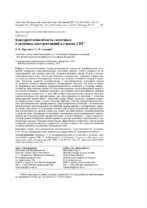Конкурентоспособность солнечных и ветровых электростанций в странах СНГ

Date
2020Publisher
Another Title
Competitiveness of Solar and Wind Power Plants in the Countries of the Commonwealth of Independent States
Bibliographic entry
Марченко, О. В. Конкурентоспособность солнечных и ветровых электростанций в странах СНГ = Competitiveness of Solar and Wind Power Plants in the Countries of the Commonwealth of Independent States / О. В. Марченко, С. В. Соломин // Энергетика. Известия высших учебных заведений и энергетических объединений СНГ. – 2020. – № 4. – С. 301-311.
Abstract
Систематизированы технико-экономические показатели возобновляемых (солнечных и ветровых) и невозобновляемых источников энергии с учетом интервала их неопределенности для условий стран СНГ. Основное внимание уделено России и государствам Центральной Азии – Казахстану, Киргизии, Таджикистану, Туркмении, Узбекистану, где имеются наиболее благоприятные условия для развития солнечной и ветровой энергетики. Проведено сравнение возобновляемых и невозобновляемых источников энергии по критерию стоимости вырабатываемой электроэнергии. Показано, что плата за выбросы парниковых газов повышает конкурентоспособность солнечных и ветровых электростанций на энергетических рынках. В случае благоприятных для возобновляемой энергетики условий солнечные и ветровые установки в ряде районов могут вырабатывать дешевую электроэнергию стоимостью 3–5 цент./(кВт⋅ч). При таких показателях они могут быть конкурентоспособными без дополнительных мер стимулирования их внедрения. С помощью математической модели REM-2 (Renewable Energy Model) проведено сравнение энергоисточников разных типов с учетом системных эффектов. Система электроснабжения включает фотоэлектрические преобразователи, ветроэлектрические установки с возможностью краткосрочного аккумулирования и потребления электроэнергии от дублирующего энергоисточника. Выполнено моделирование режимов работы фотоэлектрических преобразователей и ветротурбин по времени (часам) для разных значений прихода солнечной радиации и скорости ветра. Определены оптимальные соотношения между производством электроэнергии фотоэлектрическими преобразователями и ветротурбинами, а также предпочтительный уровень потребления электроэнергии из сети при различных климатических и экономических условиях. Показана экономическая эффективность совместного использования солнечной и ветровой энергии в странах СНГ, в первую очередь в России (за исключением северных районов) и государствах Центральной Азии.
Abstract in another language
Techno-economic indicators of renewable (solar and wind) and non-renewable energy sources are systematized, taking into account the interval of their uncertainty for the conditions of the countries of the Commonwealth of Independent States (CIS). The main attention was paid to Russia and the countries of Central Asia (Kazakhstan, Kyrgyzstan, Tajikistan, Turkmenistan and Uzbekistan), where there are the most favorable conditions for the development of solar and wind energy. A comparison of renewable and non-renewable energy sources by the criterion of the cost of generated electricity has been made. It is shown that the payment for greenhouse gas emissions increases the competitiveness of solar and wind power plants in the energy markets. Under favorable conditions for renewable energy, solar and wind installations in some areas can produce cheap electricity at a cost of 3–5 cents/(kW⋅h). With such values, they can be competitive without additional measures to stimulate their implementation. Using the mathematical model REM-2 (Renewable Energy Model), energy sources of different types were compared taking into account system effects. The power supply system consists of photovoltaic converters, wind turbines that enable the possibility of short-term accumulation of electricity and power consumption from a backup power source. Modeling of photoelectric converters and wind turbines operating modes was performed by time (hours) for different values of solar radiation arrival and wind speed. The optimal ratios between electricity production by photovoltaic converters and wind turbines, as well as the optimal level of electricity consumption from the network under different climatic and economic conditions, were determined. The economic efficiency of joint use of solar and wind energy in the CIS countries, primarily in Russia (with the exception of the northern regions) and the countries of Central Asia, is shown.
View/
Collections
- № 4[7]
